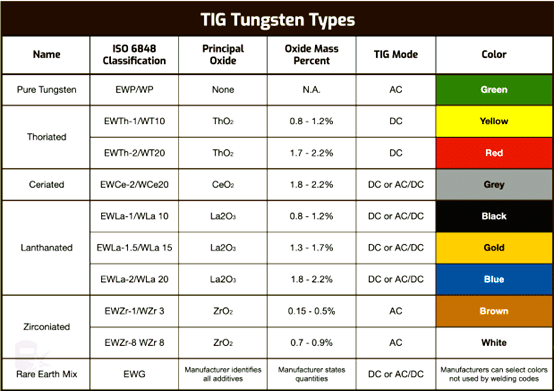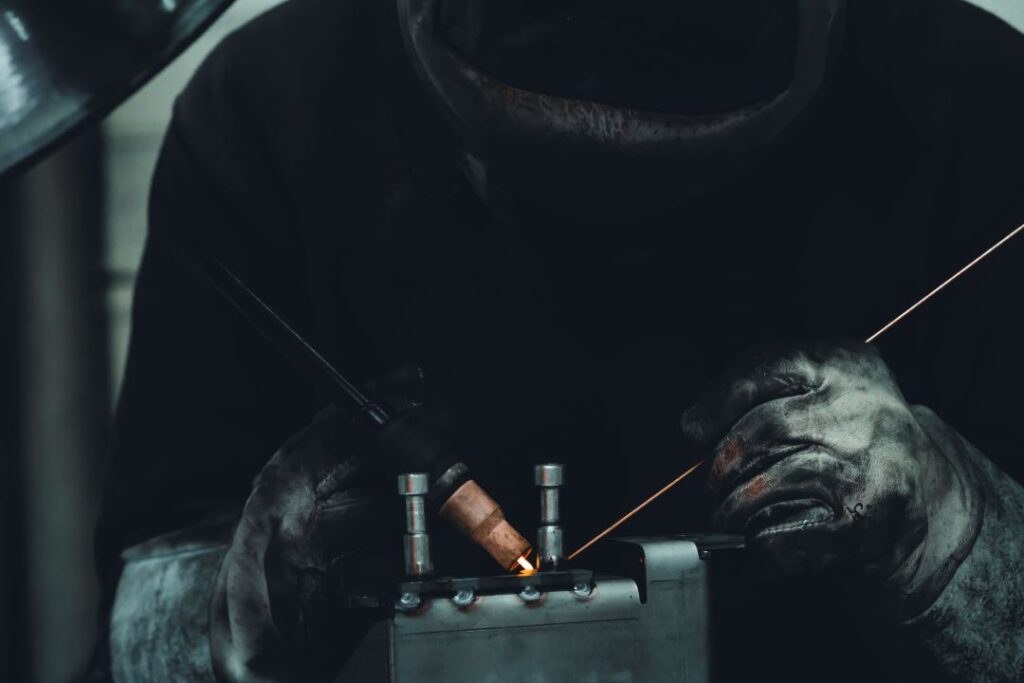Choosing the right tungsten electrode is crucial for achieving quality welds in TIG welding. Incorrect electrode selection can lead to arc instability, contamination, and poor weld quality, especially when working with different metals like aluminum or stainless steel.
To solve this, welders must understand the types of tungsten electrodes and their specific applications. Each type plays a vital role in producing clean, stable arcs from pure tungsten for aluminum to thoriated electrodes for stainless steel. This guide will walk you through the various types of tungsten electrodes, explaining their uses and tips for choosing the right one for your welding needs.
What Are Tungsten Electrodes

Tungsten welding electrodes are essential components in TIG (Tungsten Inert Gas) welding. Made from a highly durable metal, tungsten electrodes help create an electric arc between the electrode and the workpiece.
This arc is responsible for melting the metal, allowing welders to join materials precisely. Tungsten’s high melting point and excellent conductivity make it ideal for this process.
Several tungsten electrodes are for specific applications, such as welding metals like aluminum, steel, or magnesium. Selecting the correct tungsten electrode ensures stable arcs, reduced contamination, and high-quality welds, making it a critical part of welding.
Why Choosing the Right Electrode Matters
Selecting the correct tungsten electrode and the right TIG welder suppliers is critical for achieving optimal results in TIG welding. Different types of tungsten electrodes are useful in specific applications and welding metal types.
Using the wrong electrode can cause poor arc stability, contamination, and low-quality welds. For instance, pure tungsten works best with aluminum, while thoriated tungsten is more suited for steel and stainless steel.
Additionally, electrode choice affects heat resistance, durability, and arc performance. The right electrode helps ensure a smooth, consistent weld, minimizing the risk of cracking or defects. By understanding the characteristics of each tungsten type, welders can avoid common issues and produce high-quality welds for various projects and materials.
Types of Tungsten Electrodes
Several types of tungsten electrodes are for specific TIG welding applications. The choice of tungsten type influences the weld quality, arc stability, and electrode lifespan. Understanding the differences between these types can help welders select the right one for their work.

Pure Tungsten Electrodes (Green)
Pure tungsten electrodes are 100% and primarily used for AC welding, especially when welding aluminum and magnesium. They form a clean, stable arc and are known for producing a large, rounded ball at the tip, which is beneficial when welding with alternating current. Pure tungsten provides good arc stability but lacks the durability of other types, making it less suitable for high-heat applications.
Thoriated Tungsten Electrodes (Red)
Thoriated tungsten electrodes contain around 2% thorium, which improves the electrode’s heat resistance and current-carrying capacity.
These electrodes are ideal for DC welding applications, especially steel and stainless steel. Thoriated tungsten offers excellent arc starts, stability, and a longer lifespan. However, thorium is a radioactive material, so it needs special precautions during grinding and handling to avoid health risks.
Ceriated Tungsten Electrodes (Grey)
Ceriated tungsten electrodes contain 2% cerium and are best suited for low-current applications. They offer good arc starts and are famous for maintaining a stable arc at lower amperages. Ceriated tungsten is versatile and can be for both AC and DC welding. It is an excellent option for welding thin materials like stainless steel or aluminum.
Lanthanated Tungsten Electrodes (Gold, Blue)
Lanthanated tungsten electrodes, typically containing 1-2% lanthanum, are versatile and suitable for AC and DC welding.
They offer similar performance to ceriated electrodes but with a longer lifespan. Lanthanated tungsten provides excellent arc starts, stability, and minimal electrode wear, making it a preferred choice for many welders who work with various metals, including steel, aluminum, and copper.
Rare Earth Tungsten Electrodes (Purple)
Rare earth tungsten electrodes contain rare earth elements like yttrium and zirconium, providing excellent performance across various welding applications.
These electrodes are designed to offer a stable arc, high current-carrying capacity, and a long lifespan. They are particularly effective in DC welding but can also be used in AC applications, offering versatility similar to lanthanated tungsten.
Zirconiated Tungsten Electrodes (White, Brown)
Zirconiated tungsten electrodes contain a small percentage of zirconium oxide, which enhances arc stability in AC welding, particularly with aluminum.
Zirconiated tungsten maintains a clean, stable arc and resists contamination. These electrodes are ideal for high-precision work, as they reduce the risk of tungsten spitting, making them a preferred option for welding materials like aluminum and magnesium.
Tungsten Electrode Types and Their Best Uses
| Electrode Type | Color Code | Composition | Best Use |
| Pure Tungsten | Green | 100% Tungsten | AC welding (Aluminum, Magnesium) |
| Thoriated Tungsten | Red | 2% Thorium | DC welding (Steel, Stainless Steel) |
| Ceriated Tungsten | Grey | 2% Cerium | Low current, AC/DC (Stainless Steel, Aluminum) |
| Lanthanated Tungsten | Gold, Blue | 1-2% Lanthanum | AC/DC welding (Steel, Aluminum, Copper) |
| Rare Earth Tungsten | Purple | Mixed Rare Earth Elements | Versatile AC/DC welding |
| Zirconiated Tungsten | White, Brown | Zirconium Oxide | AC welding (Aluminum, Magnesium) |
Tungsten Electrode Tip Shapes
The shape of the tungsten electrode tip plays a significant role in TIG welding performance. There are two main tip shapes in welding: ball end and sharp end, each suited for specific applications and materials.

Ball End
The ball end tip is a common choice for AC welding, especially when working with aluminum or magnesium. This shape helps maintain a stable arc and prevents the electrode from deteriorating too quickly during welding.
The ball end is formed naturally as the tungsten heats up in AC welding. It is important to monitor the size of the ball to ensure it does not exceed the diameter of the electrode, as this can lead to poor arc control and contamination.
Sharp End
A sharp end is most suitable for DC welding and is often for metals like stainless steel or copper. Sharpening the tungsten to a pointed shape creates a focused arc that improves precision and reduces the risk of arc wander.
This tip shape is ideal for welding with lower amperages and provides a more stable arc when welding in DC mode. Grinding the tungsten along its length rather than across the electrode is crucial to prevent arc instability.
Factors to Consider When Choosing Tungsten Electrodes
Selecting the right tungsten electrode depends on several factors, including the welding current, the material being welded, and the balance between cost and performance.

Welding Current (AC/DC)
The choice of tungsten electrode varies based on the type of welding current used—AC or DC. Pure tungsten or zirconiated tungsten is suitable for AC welding, especially when working with materials like aluminum or magnesium.
These electrodes provide stable arc characteristics under AC conditions. In contrast, thoriated, ceriated, or lanthanated tungsten is preferred for DC welding because it can handle higher heat and offer better arc stability, especially when welding steel and stainless steel.
Material and Thickness
The welded material and its thickness also affect the selection of tungsten electrodes. For instance, pure tungsten is ideal for softer metals like aluminum, while thoriated or lanthanated electrodes are better for harder metals like stainless steel or copper. Different materials require specific electrode properties to ensure arc stability and minimal contamination during the welding process.
Cost vs. Performance
While some tungsten electrodes are more expensive, they often offer better performance and durability. For example, lanthanated and thoriated electrodes last longer and provide better arc stability, making them more cost-effective.
Welders must balance the upfront cost of the electrodes with their performance to select the most efficient option for their specific needs. High-performance electrodes can reduce the need for frequent replacements, saving costs in the long run.
Tungsten Electrode Lifespan
The lifespan of a tungsten electrode depends on its type and how it is used during welding. Different tungsten types offer varying levels of durability.

Durability of Different Tungsten Types
Thoriated and lanthanated tungsten electrodes are known for their long lifespan due to their ability to withstand high heat and maintain arc stability.
While effective for AC welding, pure tungsten tends to have a shorter lifespan as it wears down faster under heat. Zirconiated electrodes are also durable but primarily suited for AC welding applications.
What Affects Electrode Lifespan
Several factors impact the lifespan of a tungsten electrode, including the welding current, the material being welded, and how the electrode is prepared and maintained.
Incorrect grinding techniques or overheating the electrode can reduce its lifespan. Proper handling and using the right electrode for each welding application help extend the electrode’s durability, ensuring consistent performance throughout its use.
Tungsten Electrode for Specific Metals
Tungsten Electrode for Stainless Steel
- Thoriated tungsten (Red): Ideal for DC welding stainless steel, offering excellent arc stability and heat resistance.
- Lanthanated tungsten (Gold, Blue): Suitable for both AC and DC welding of stainless steel, providing a longer lifespan and consistent performance.
- Ceriated tungsten (Grey): Good for low-current applications, commonly used for precision welding on thinner stainless steel materials.
Tungsten Electrode for Aluminum
- Pure tungsten (Green): Best for AC welding of aluminum, providing a stable arc and forming a ball end for smooth welding.
- Zirconiated tungsten (White, Brown): Used for AC welding, especially when welding aluminum, as it offers excellent arc stability and reduces the risk of contamination.
- Lanthanated tungsten (Gold, Blue): A versatile option for AC welding aluminum, providing better durability and arc control than pure tungsten.
Recommended Tungsten Electrodes for Different Metals and Welding Currents
| Metal Type | Recommended Tungsten Electrode | Welding Current (AC/DC) | Advantages |
| Aluminum | Pure Tungsten (Green), Zirconiated (White) | AC | Stable arc, reduces contamination |
| Stainless Steel | Thoriated Tungsten (Red), Lanthanated (Gold, Blue) | DC | Excellent arc stability, heat resistance |
| Steel | Thoriated Tungsten (Red), Lanthanated (Gold) | DC | Better durability, high heat tolerance |
| Copper | Lanthanated Tungsten (Gold, Blue) | AC/DC | Versatile, consistent arc performance |
| Magnesium | Pure Tungsten (Green) | AC | Stable arc, clean welds |
Final Thoughts
Choosing the right tungsten electrode from reliable welding suppliers is essential for achieving high-quality welds in TIG welding. Each type of tungsten offers distinct advantages, depending on the material and welding process.
Understanding the differences between pure, thoriated, lanthanated, and other types ensures better arc stability, reduced contamination, and increased electrode lifespan. Whether welding aluminum or stainless steel, selecting the appropriate tungsten electrode can significantly improve your results.
FAQs
What is the best tungsten electrode for aluminum?
Pure tungsten (Green) and zirconiated tungsten (White) are the best for AC welding aluminum, providing stable arcs and reducing contamination.
Which tungsten electrode is used for stainless steel?
Thoriated tungsten (Red) is common for DC welding stainless steel due to its excellent heat resistance and arc stability.
Can I use the same tungsten electrode for AC and DC welding?
Lanthanated tungsten (Gold, Blue) can for both AC and DC welding, making it a versatile option for multiple applications.
How often should I replace a tungsten electrode?
Replace your tungsten electrode when it shows signs of wear, such as erosion or difficulty maintaining a stable arc. Proper maintenance can extend its lifespan.



